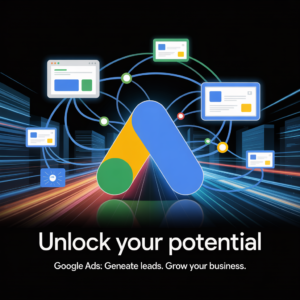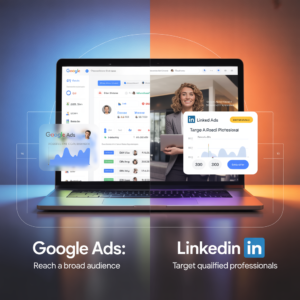Definition: Lead generation is the process of attracting and converting potential customers into interested prospects for your business. It’s a fundamental aspect of any digital marketing strategy, designed to drive conversions and sales.
Importance: Effective lead generation is crucial for business growth, especially in the digital age. As more businesses embrace online marketing, having a clear and efficient strategy for generating leads helps ensure a constant stream of potential customers. Whether you’re looking to drive awareness, increase conversions, or build a long-term customer base, generating quality leads is essential.
Overview: This article compares two prominent platforms for lead generation—Google Ads and LinkedIn Ads—to help you determine which one best aligns with your business objectives. We’ll break down the benefits, challenges, and key performance metrics of each, providing you with the insights needed to choose the right platform for your business.
Google Ads for Lead Generation
What Is Google Ads?
Platform Overview: Google Ads is an online advertising platform where advertisers pay to display brief advertisements, product listings, video content, and service offerings to web users. Google Ads leverages the power of the Google search engine and its vast display network to connect businesses with their target audiences.
Reach: Google Ads has an enormous reach, thanks to its connection with the world’s most used search engine. It offers businesses access to millions of potential customers across Google Search, YouTube, and Google’s Display Network. This widespread reach makes it an excellent platform for businesses looking to expand their visibility and attract leads at scale.
Advantages of Google Ads for Lead Generation
-
High Intent Audience: Google Ads targets users actively searching for specific products or services. This signals a higher intent to convert, making Google Ads a powerful tool for lead generation. A study by WordStream shows that Google Ads’ click-through rate (CTR) for search ads averages 3.17%, indicating that people are more likely to act when they are actively searching.
-
Extensive Reach: Through Google’s search engine and partner sites, businesses can reach a broad, global audience. This is especially beneficial for those looking to attract a large volume of leads.
-
Flexible Budgeting: Google Ads allows for flexible budgeting with cost-per-click (CPC) and cost-per-impression (CPM) options. This makes it easier for businesses of all sizes to control their advertising spend while driving lead generation.
Google Ads vs. LinkedIn Ads: Which Platform Is Best For Lead Generation?

Challenges with Google Ads
-
High Competition: Popular keywords can be expensive due to competitive bidding, especially in industries like insurance or legal services. As competition increases, so do the costs of securing top spots in search results.
-
Quality of Leads: Due to its broad targeting capabilities, the quality of leads can vary. Without careful keyword targeting, businesses might attract clicks that don’t convert into qualified leads.
-
Complexity: Google Ads requires expertise in campaign optimization and ad targeting. Without proper management, campaigns can waste resources, resulting in poor lead quality.
LinkedIn Ads for Lead Generation
What Is LinkedIn Ads?
Platform Overview: LinkedIn Ads is an advertising platform within LinkedIn that allows businesses to target professionals based on specific criteria such as job title, industry, company size, and more. It’s designed for B2B lead generation and is ideal for companies that want to target decision-makers and high-level professionals.
Professional Audience: LinkedIn offers access to a vast network of professionals across a range of industries. This makes it an invaluable tool for businesses targeting professionals, executives, and decision-makers who can influence purchasing decisions.
Advantages of LinkedIn Ads for Lead Generation
-
Precise Targeting: LinkedIn Ads provides precise targeting based on professional attributes like job title, company size, industry, and seniority. This helps businesses reach the right audience and generate high-quality leads.
-
B2B Focus: LinkedIn is ideal for businesses looking to generate B2B leads. The platform’s professional focus allows businesses to connect with other businesses, making it the go-to choice for companies offering business services or products.
-
Lead Gen Forms: LinkedIn has built-in lead gen forms that make it easy for users to submit their information without ever leaving the platform. This streamlined process increases the likelihood of capturing qualified leads.

Challenges with LinkedIn Ads
-
Higher Costs: LinkedIn Ads generally has a higher cost-per-click (CPC) compared to Google Ads. This is largely due to the platform’s professional focus and more targeted audience. The average CPC on LinkedIn ranges from $5 to $15, reflecting its B2B orientation.
-
Smaller Audience: The reach on LinkedIn is limited to users within the platform. While it provides access to a highly targeted professional network, it can be restrictive in terms of audience size compared to Google Ads’ extensive reach.
-
Longer Sales Cycle: B2B sales often take longer, requiring sustained engagement with potential leads. LinkedIn Ads, while powerful for lead generation, is typically better for building relationships over time rather than driving immediate sales.
Google Ads vs. LinkedIn Ads for Lead Generation
Audience Targeting Comparison
-
Google Ads: Google Ads targets users based on their search behavior, demographics, and interests. This makes it a great option for businesses seeking to reach a broader audience, including both consumers and professionals.
-
LinkedIn Ads: LinkedIn Ads targets based on professional attributes like job title, company size, and industry. This makes it more suitable for B2B lead generation, as businesses can reach decision-makers directly.
Cost Analysis
-
Google Ads: The average CPC on Google Ads ranges from $2 to $10, depending on the industry. Competitive keywords can drive up costs, but the platform provides flexibility for businesses of all sizes.
-
LinkedIn Ads: The average CPC on LinkedIn Ads ranges from $5 to $15. While higher than Google Ads, this cost reflects the highly targeted nature of the platform and its focus on professionals.
Lead Quality
-
Google Ads: Leads generated via Google Ads can vary in quality, depending on how well campaigns are optimized. Keywords must be carefully selected to ensure that the leads are relevant and likely to convert.
-
LinkedIn Ads: LinkedIn Ads typically generate higher-quality leads due to its more precise targeting capabilities, particularly for B2B businesses aiming to engage with professionals and decision-makers.
Best Use Cases
-
Google Ads: Best suited for businesses that need quick conversions and want to generate leads from a broad audience with high purchase intent. It’s ideal for industries like retail, local services, or e-commerce.
-
LinkedIn Ads: Ideal for B2B businesses aiming to build relationships with key decision-makers and generate high-quality, professional leads. LinkedIn Ads excels in industries like SaaS, consulting, and professional services.

Conclusion and Recommendations
Both Google Ads and LinkedIn Ads offer unique advantages for lead generation. Google Ads provides broad reach and flexibility, making it suitable for businesses aiming for quick conversions, while LinkedIn Ads offers precise targeting and is best for B2B lead generation.
Recommendation: Choose the platform that aligns with your business goals, target audience, and budget. Google Ads might be better for businesses with a shorter sales cycle and broad target audiences, while LinkedIn Ads is ideal for companies looking to nurture relationships with decision-makers.
Final Tip: For a comprehensive lead generation strategy, consider integrating both platforms. Using Google Ads for immediate, high-intent leads and LinkedIn Ads for building long-term professional relationships can provide the best of both worlds.
Read More Blogs: How to Make User-Generated Content Work for You in 2025

